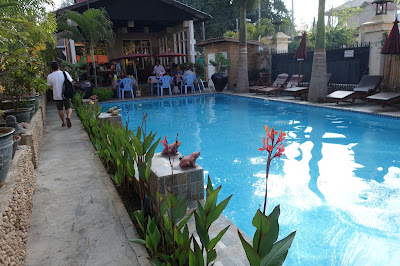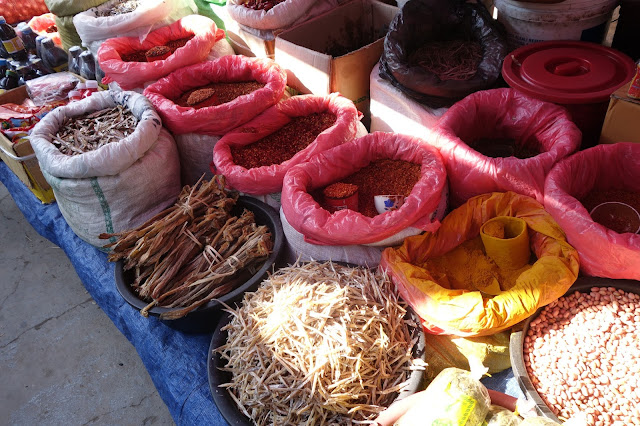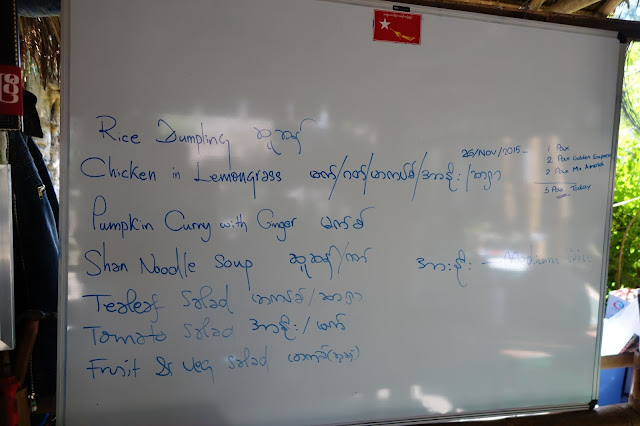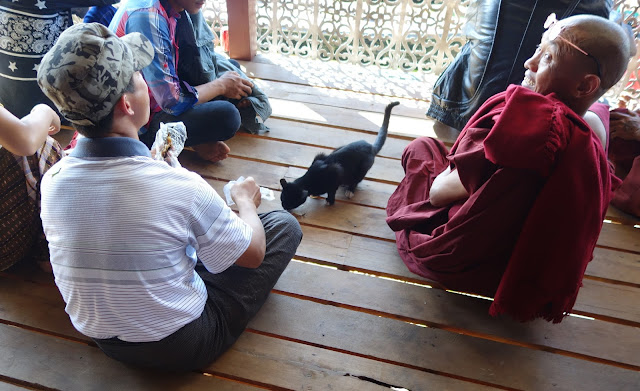My Trip to Burma: Inle Lake Day 2 - Cooking Class, the Jumping Cat Monastery, assorted craftspeople, and the best street food.
Today we get a good taste - literally - of what Burma is all about, because we're starting the day with a cooking lesson at the Bamboo Delight Cooking School. I set this up weeks in advance as a surprise for Mark. Cooking is his passion, especially Asian cuisine. He wasn't expecting this, so he was majorly psyched.
 First was breakfast at the hotel. The breakfast room overlooks the pool, which is always nice.
First was breakfast at the hotel. The breakfast room overlooks the pool, which is always nice.
Here's the view from the breakfast area.
 Their banana pancakes are different than American pancakes, and certainly not like the kind I'm obsessed with at Cowgirl in New York, but I'm not complaining. It was great.
Their banana pancakes are different than American pancakes, and certainly not like the kind I'm obsessed with at Cowgirl in New York, but I'm not complaining. It was great. We were met at our hotel by Nyein Nyein who walked us through the town, to the place where we were supposed to meet Lesley, the guy who runs the cooking school. From there, we go to a local market to buy the ingredients for the lunch we were going to cook.
 On our walk into town, we passed the Yadana Mon Aung Pagoda. This pagoda has a distinctive stepped, golden stupa and is the holiest and
most interesting of the Buddhist monuments in Nyaungshwe. It has a unique octagonal shape in all of
Myanmar, which is saying something, given how many thousands of stupas there
are in this country.
On our walk into town, we passed the Yadana Mon Aung Pagoda. This pagoda has a distinctive stepped, golden stupa and is the holiest and
most interesting of the Buddhist monuments in Nyaungshwe. It has a unique octagonal shape in all of
Myanmar, which is saying something, given how many thousands of stupas there
are in this country. 

The interior is a museum of sorts, featuring dusty ceramics, clocks carvings, and other treasures hoarded by the monks over the years.
Of course, I was more drawn to the adorable little puppy outside the pagoda. Such a little sweetheart.
I can't begin to count how many sweet animals I've encountered on my travels. I would have loved to take this lil' guy home. Sigh.
 Just past the pagoda, we encountered a line of monks. There is a trio of monasteries hugging the eastern bank of the small
Mong Li Canal that's nearby. From south to north are
the Kan Gyi Kyaung, the Shwe Gu Kyaung, and the Hlaing Gu Kyaung. Monks from these monasteries file through the town each
morning at dawn with their alms bowls. I confess, I saw them and starting thinking of the theme song from the Monkees: Here they come, walking down the street... Of course, I sang "Hey hey, we're the Monks" in my head.
Just past the pagoda, we encountered a line of monks. There is a trio of monasteries hugging the eastern bank of the small
Mong Li Canal that's nearby. From south to north are
the Kan Gyi Kyaung, the Shwe Gu Kyaung, and the Hlaing Gu Kyaung. Monks from these monasteries file through the town each
morning at dawn with their alms bowls. I confess, I saw them and starting thinking of the theme song from the Monkees: Here they come, walking down the street... Of course, I sang "Hey hey, we're the Monks" in my head. Nyaungshwe
is on an orderly grid plan, with Yone Gyi road, a broad main street, running
east and west. There are lots of
hardware shops, restaurants, and cafes on this street. There’s a Main Road that runs north and
south.
Nyaungshwe
is on an orderly grid plan, with Yone Gyi road, a broad main street, running
east and west. There are lots of
hardware shops, restaurants, and cafes on this street. There’s a Main Road that runs north and
south.  Just northeast of where the road
intersects is Mingalar Market, the main source of fresh produce. This is where we met up with Lesly, the guy who runs the Bamboo Delight Cooking School with his wife, Sue. That's him in the middle, with the sunglasses, looking over the day's selection, deciding what we should bring back to the cooking class.
Just northeast of where the road
intersects is Mingalar Market, the main source of fresh produce. This is where we met up with Lesly, the guy who runs the Bamboo Delight Cooking School with his wife, Sue. That's him in the middle, with the sunglasses, looking over the day's selection, deciding what we should bring back to the cooking class. Lots of stuff to choose from. I like this market. Very local, and a real family affair for many of the merchants. This was a really great market. Sorry if I took too many photos! The people there were so nice, I couldn't help myself!
Lots of stuff to choose from. I like this market. Very local, and a real family affair for many of the merchants. This was a really great market. Sorry if I took too many photos! The people there were so nice, I couldn't help myself!


 Lesly purchased all of the ingredients, and we all hopped in the back of a truck and headed over to the school. There were seven people in the class that day: me and Mark, another gay couple from Germany (Sascha and Markos), a straight couple from Germany (didn't catch their names), and one guy from the Philippines.
Lesly purchased all of the ingredients, and we all hopped in the back of a truck and headed over to the school. There were seven people in the class that day: me and Mark, another gay couple from Germany (Sascha and Markos), a straight couple from Germany (didn't catch their names), and one guy from the Philippines. They gave everybody an apron. There's Mark proudly donning his.
 Mark is the cook in the house. I never touch a dish. But I have to say, I held my own, and I made a pretty kickass lemongrass chicken.
Mark is the cook in the house. I never touch a dish. But I have to say, I held my own, and I made a pretty kickass lemongrass chicken.
 While we ate dinner, we listened as Sue told us the very inspiring story of her father and how he welcomed less fortunate people into his home and taught her to have kindness and compassion for those less fortunate than her. This cooking school is more than just a place to cook and eat. It's their home, also an orphanage, run by Sue and Lesly. Any food remaining after these classes is donated to hungry people in town. In addition, 15% of every class fee (only $20, by the way. Incredible value) goes toward the education of local children. Local children come to read and learn here throughout the year.
While we ate dinner, we listened as Sue told us the very inspiring story of her father and how he welcomed less fortunate people into his home and taught her to have kindness and compassion for those less fortunate than her. This cooking school is more than just a place to cook and eat. It's their home, also an orphanage, run by Sue and Lesly. Any food remaining after these classes is donated to hungry people in town. In addition, 15% of every class fee (only $20, by the way. Incredible value) goes toward the education of local children. Local children come to read and learn here throughout the year.  Sue and Lesly have taken it upon themselves to help get books and other educational materials for these kids who would otherwise never have this kind of opportunity. She really is a spectacular person. Not only was the class great, and the food great, but you really feel good knowing that you've contributed to a good cause.
Sue and Lesly have taken it upon themselves to help get books and other educational materials for these kids who would otherwise never have this kind of opportunity. She really is a spectacular person. Not only was the class great, and the food great, but you really feel good knowing that you've contributed to a good cause.  Of course, I have to throw in a picture of me playing with their two sweet doggies!
Of course, I have to throw in a picture of me playing with their two sweet doggies! Okay, time to head to the jetty and hit the lake! A 3.5 mile feeder canal joins the town to the northern shore of the Inle Lake. Many little jetties line the canal, and fleets of motorized long-tailed boats leave on sightseeing trips throughout the day. The sound of their engines churning through the water is the soundtrack of the town. At the jetty was this map showing the lake. Note Nyaung Shwe at the top right. That's where we are. That tiny little red line from the town to the lake is the canal we're about to travel on.
Okay, time to head to the jetty and hit the lake! A 3.5 mile feeder canal joins the town to the northern shore of the Inle Lake. Many little jetties line the canal, and fleets of motorized long-tailed boats leave on sightseeing trips throughout the day. The sound of their engines churning through the water is the soundtrack of the town. At the jetty was this map showing the lake. Note Nyaung Shwe at the top right. That's where we are. That tiny little red line from the town to the lake is the canal we're about to travel on. The canal was peaceful and calm. After about 10 minutes, we hit the actual lake. That was a pretty great moment, seeing the waterway widen dramatically like that.
The canal was peaceful and calm. After about 10 minutes, we hit the actual lake. That was a pretty great moment, seeing the waterway widen dramatically like that.
So many sites in Myanmar fall into the category of “must
see” that the phrase “must see” is becoming meaningless. With that in mind, all I can say is that Inle
Lake is, undoubtedly, a “must MUST see.” It’s not just the natural beauty of the
lake. The numerous stilt villages on the
lake’s periphery, the fishermen propelling their boats using their famous
one-leg-rowing technique, the floating gardens, the tranquility… Inle Lake is a
world apart from the rest of Burma. The
Intha people who live in stilt villages along the fringes of the lake have
adapted their way of life in perfect synchrony with the seasonal ebb and flow
of the shoreline, where slender-topped stupas overlook a mosaic of rice paddies
and floating vegetable gardens.
It’s a popular tourist destination, but the lake is so huge
that it’s only when your boat pulls up at one of the interesting stops that you
notice how many other foreigners are around.
Despite the tourists, the markets dotting the lake are aimed more at the
villagers of the various ethnic groups that live around the lake – the Shan,
Pa-O, Kayah, and Danu.
 The Intha people adapted to their climate and ecosystem amazingly well. Fishing is a major occupation for the Intha, and they developed a distinctive one-legged rowing style which makes for the perfect picture postcard. Here's a good one that I took of this guy with his fishing net.
The Intha people adapted to their climate and ecosystem amazingly well. Fishing is a major occupation for the Intha, and they developed a distinctive one-legged rowing style which makes for the perfect picture postcard. Here's a good one that I took of this guy with his fishing net.
You'll see many more of these pictures in these posts. Taking photos of these fishermen is addictive.
 Our first stop was Nga Hpe Kyaung. Previously referred to as the Jumping Cat
Monastery because it was famed for the cats that the monks had trained to jump
through little hoops, this monastery no longer really does this. It’s still an attractive place filled with
elaborate carvings.
Our first stop was Nga Hpe Kyaung. Previously referred to as the Jumping Cat
Monastery because it was famed for the cats that the monks had trained to jump
through little hoops, this monastery no longer really does this. It’s still an attractive place filled with
elaborate carvings. 


Nyein Nyein intro-duced us to a prom-inent monk. I guess he's and his fellow monks are special enough to get their own private bathroom!
One of the monks was feeding a cat.
 It may no longer be the Jumping Cat monastery, but there were definitely a couple of cats around. This tortie was pretty sweet.
It may no longer be the Jumping Cat monastery, but there were definitely a couple of cats around. This tortie was pretty sweet.
This little boy was definitely interested in these two little kittens. I managed to get a pretty good photo of him with them.

 The terrace out back had a nice view of some boats that were docked, and a great view across the lake. On one of the docked boats was a sleeping black cat. Not a bad life.
The terrace out back had a nice view of some boats that were docked, and a great view across the lake. On one of the docked boats was a sleeping black cat. Not a bad life.
I think I composed some of my best photos from the deck at the back of the monastery.



Okay, time to get back in our boat and head to our next desti-nation. The silk and lotus workshop.
 With this view, getting there was half the fun.
With this view, getting there was half the fun.As we made our way to the silk and lotus shop, we passed many of the stilt houses on the lake. These houses are occupied by the Intha people who make up most of the population of Inle Lake (estimated to be between 70,000 and 100,000). They live their entire lives, pretty much, on this lake. Here are some of the homes:
 The one-legged rowing technique is taught early. Here's a young guy, out on the lake, doing it.
The one-legged rowing technique is taught early. Here's a young guy, out on the lake, doing it. We arrived at the Myat Pwint Chel Silk and Lotus Workshop. Here, they make thread that gets woven into scarves, handkerchiefs, napkins, shirts, etc. Most things in Burma are inexpensive, but this is the one thing that was pretty pricey. Very pricey. This is because of the amount of time and effort it takes to make the thread.
We arrived at the Myat Pwint Chel Silk and Lotus Workshop. Here, they make thread that gets woven into scarves, handkerchiefs, napkins, shirts, etc. Most things in Burma are inexpensive, but this is the one thing that was pretty pricey. Very pricey. This is because of the amount of time and effort it takes to make the thread. 
A woman sits next to a pile of lotus stems. She grabs a few and cuts them, a few inches at a time.

After she makes the cut, she pulls them apart, and a tiny little wisp of gooey material stretches out between the pieces. She let me gently touch the wispy fibers.

She rolls this gooey stuff on a table, making it into a thread. You can see what she's created already, on the spool. Not sure if you can see the thread as it falls off the table, on the left, before it gets to the spool a few inches away.
This thread eventually gets woven into whatever it's eventually going to be. The work is unbelievably tedious and monotonous. She sits there all day, cutting hundreds of pieces of lotus.

 The thread is then dyed. e thread is woven on a loom. It's all done by hand. Nothing mechanical. It is then woven on a loom. No mass machinery. Just a bunch of looms, in a room upstairs, where women weave the thread into cloth.
The thread is then dyed. e thread is woven on a loom. It's all done by hand. Nothing mechanical. It is then woven on a loom. No mass machinery. Just a bunch of looms, in a room upstairs, where women weave the thread into cloth. 

A small handkerchief or table napkin was about $50. Scarves were around $100. For Burma, this is very expensive.
Our next stop was a blacksmith. The guys below were rhythmically hammering away at the metal.
 In a little workshop in the back, artisans made little statues and tchotchkes. Of course, I was drawn to the cat ones :)
In a little workshop in the back, artisans made little statues and tchotchkes. Of course, I was drawn to the cat ones :)After that was a boat building workshop. As you can see, today is devoted to seeing the various vocations of the Shan people, particularly the Intha.
 After that was the cheroot factory. Cheroots are little cigars. Unlike China, where everyone smokes, the Burmese don't smoke a whole lot of cigarettes. The big vice is chewing betel leaves. If someone smokes, it's often a cheroot.
After that was the cheroot factory. Cheroots are little cigars. Unlike China, where everyone smokes, the Burmese don't smoke a whole lot of cigarettes. The big vice is chewing betel leaves. If someone smokes, it's often a cheroot.
Time to head back to Nyaungshwe. It was late in the afternoon and the sun was starting to go down. The weather was perfect and the boat ride was great. This is the only way to get around Inle Lake, but I can't imagine ever getting tired of it.

 We docked at the jetty and strolled back to the Mingalar Inn to chill out for few hours before going out to dinner. Nyaungshwe has many many restaurants. They also have a night market, which was highly recommended by everyone we spoke to. This is the best place to get really authentic food, in the most authentic atmosphere, at incredible prices. It was only a few blocks from the hotel, so off we went.
We docked at the jetty and strolled back to the Mingalar Inn to chill out for few hours before going out to dinner. Nyaungshwe has many many restaurants. They also have a night market, which was highly recommended by everyone we spoke to. This is the best place to get really authentic food, in the most authentic atmosphere, at incredible prices. It was only a few blocks from the hotel, so off we went. 
It was one stall after the next. All locals; not a tourist to be seen. Huge variety of stuff to choose from.
Check out this menu. The dishes on the left and the right are the same, except on the right, you add meat. The price: 500 for no meat. That's 40 cents. 1000 for meat dishes. 80 cents!
 We settled on this menu. We ordered ginger salad, carrot salad, Shan noodles with tofu gravy, and one other meat curry dish. And a beer. There's Mark sitting on the plastic red stool. Communal tables only.
We settled on this menu. We ordered ginger salad, carrot salad, Shan noodles with tofu gravy, and one other meat curry dish. And a beer. There's Mark sitting on the plastic red stool. Communal tables only. There's the ginger salad.
There's the ginger salad.  Here's the Shan noodles with the tofu. It was spectacular.
Here's the Shan noodles with the tofu. It was spectacular. 
And here's the carrot salad. The total cost of our meal, with the beer, was $6.
 We passed the Yadana Mon Aung pagoda again on the way back. They were having a lighting festival. Kids were putting candles in every nook on the outside wall, and then lighting them.
We passed the Yadana Mon Aung pagoda again on the way back. They were having a lighting festival. Kids were putting candles in every nook on the outside wall, and then lighting them. The light from the candles was great, from a photographer's perspective, and it made for some great photos.
 I got in on the act, lighting one myself.
I got in on the act, lighting one myself.Anyway, that's it for today. Tomorrow comes something I've been anticipating for months: a trip to the Inthar Heritage House, home of the Burmese cat sanctuary!








































































Comments
Post a Comment